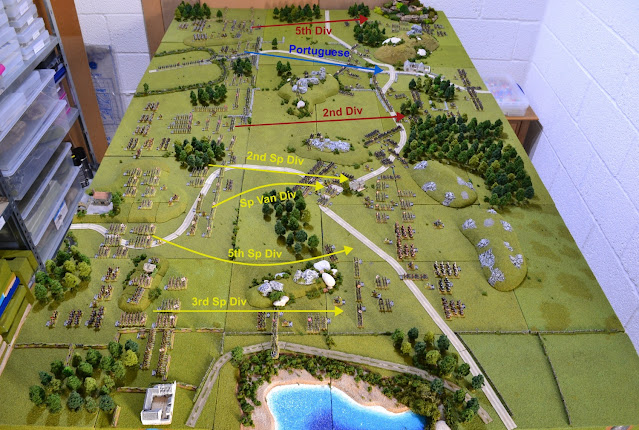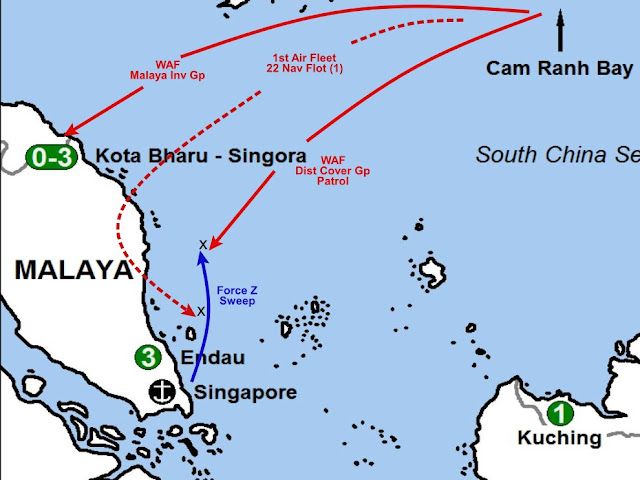The Prince of Wales and Repulse inflicted severe damage to the IJN before their demise. One IJN battlecruiser sunk and another so badly damaged it had to be removed from theatre for repairs. Additionally, two heavy cruisers are now drydocked for repair, 3 destroyers sunk and 5 damaged also requiring repair, one of which was crippled and needed to retire from theatre.
The 3 British escorting destroyers were also damaged and now undergoing repair in Singapore.
Against this backdrop, the campaign proper begins. I will deal with each turn phase in order as in the scenario book:
1. General Intelligence.
At 0330 hours in Manilla on 8th December 1941, Admiral Hart was awoken with the news of the air raid on Pearl Harbour. His first order to the fleet was simply, "Japan has started hostilities. Govern yourselves accordingly". Japanese troops invaded Hong Kong; Thailand, Malaya (including Kota Bharu); and Batan Island, Aparri, Vigan, and Legaspi in the Philipines. The IJN's 11th Air Fleet land-based aircraft from Taiwan attacked and crippled the USAFFE air forces on Luzon and then the naval base at Cavite. Force Z has effectively been destroyed.
2. Japanese Theatre Events.
Reinforcement: Add CVS Mizuho to IJN Eastern Attack Force (EAF) OB. This ship is available after this turn.
3. Allied Theatre Events.
A convoy requires escorts from WESGROUP. The light cruiser HMS Danae with the destroyers HMS Stronghold and HMS Thanet are detached to provide that escort.
4. Weather Forecast.
Dice rolls were made to determine any adjustments to the weather during the engagements phase. For the Western Attack Force (WAF) the result was a +1 to dice rolls. For the EAF it was -1. More of this later during the engagement phase.
5. Japanese Command Decisions.
EAF:
Medium invasion convoy - target Davao in the Philippines. 10 merchant/transport ships escorted by the Seaplane carrier Chitose and one destroyer.
Medium invasion convoy - target Jolo in the Philippines. 8 merchant/transport ships escorted by the light cruiser Jintsu and 2 destroyers.
Carrier group lead by the light aircraft carrier Ryojo. Escorted by the heavy cruiser Haguro and 2 destroyers.
Distant Cover Group - a patrol tasking covering both convoys. Consisting of the heavy cruisers Nachi and Myoko with 2 destroyers.
WAF:
Large supply convoy supporting the Malayan invasion - destination Kota Bharu. 12 merchant ships escorted by the seaplane tenders Kamikara Maru and San'yo Maru. The heavy cruisers Kumano, Suzuya, light cruiser Sendai and 8 destroyers.
Small invasion convoy - target Miri in Brunei. 4 merchant/transport ships escorted by the seaplane tender Sagara Maru and 3 destroyers.
Distant Cover Group - patrol consisting of the heavy cruisers Chokai, Mikuma and Mogami with 6 destroyers.
6. Allied Intelligence.
Asiatic Fleet Subs report contact! Allies receive a report on a randomly determined IJN Patrol/Convoy mission increasing the possibility of intercepting or evading that mission.
7. Allied Command Decisions.
EASGROUP (US Navy) based in Tarakan, Borneo.
Sweep mission with the target of intercepting one of the Philippines invasion convoys. Consisting of the light cruiser Marblehead and 5 elderly Clemson class destroyers.
WESGROUP (Royal Navy) based in Singapore.
Sweep mission with the intention of intercepting the supply convoy. Consisting of the heavy cruiser Exeter, the light cruisers Dragon and Durban, and 4 destroyers.
8. Japanese Intelligence.
Loose lips.... Reveal any reinforcements received this turn by the Allied Theatre Events and/or Command Decisions. (This will have no value for the Japanese this turn).
9. Engagements.
This will be the subject of the next post.


























